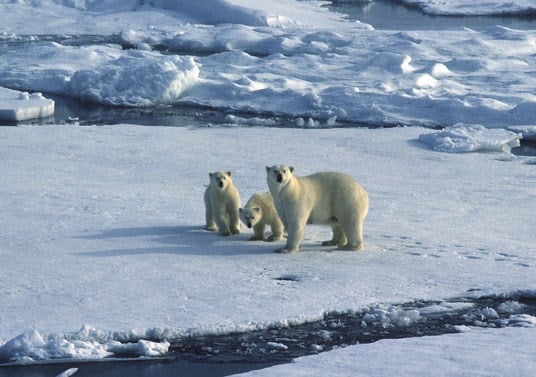Climate change and pollution is threatening the polar bear
Historical archive
Published under: Stoltenberg's 2nd Government
Publisher: Ministry of the Environment
Press release | Date: 01/06/2007
Climate change and environmentally hazardous substances are the most important threats to polar bears. Climate change may reduce the extent of sea-ice significantly, and thus reduce the habitat available for polar bears for feeding and reproduction.
Climate change and environmentally hazardous substances are the most important threats to polar bears. Climate change may reduce the extent of sea-ice significantly, and thus reduce the habitat available for polar bears for feeding and reproduction. Hazardous substances like PCBs are also a threat to the health and reproductive capacity of polar bears. New scientific evidence indicates that the survival rate of cubs is falling, and that mortality is increasing also for grown-up bears.
- Whether the polar bear will survive as a species is entirely up to us, and whether we succeed in our efforts to reduce releases of greenhouse-gases and hazardous substances from human activities worldwide, says the Norwegian Minister of the Environment Helen Bjørnøy.

The most important threat to polar bears is climate change and the resulting melting of the Arctic sea-ice, in particular during summer. Photo: Thor Siggerud, Norsk Polarinstitutt.
The most important threat to polar bears is climate change and the resulting melting of the Arctic sea-ice, in particular during summer. If this development is allowed to continue, the result might be that the sea ice disappears from the polar basin altogether in the summer season. A likely consequence will be the extinction of the polar bear as a species. Norway will put his important issue high on the agenda of relevant international forum dealing with climate change.
- Norway is promoting a more comprehensive and ambitious international post-Kyoto climate regime. We will also ensure compliance with our commitments to reduce emissions nationally as well as internationally, says Bjørnøy.
Releases of hazardous substances pose another serious threat to polar bears. Such substances are accumulating in Arctic food webs and may affect the health, reproductive capacity and survival of top predators such as polar bears. Even though the main sources of releases are far away from the Arctic, polar bears are still exposed through long range transport of such pollutants. This problem can only be solved through strengthening the international regime to stop releases of hazardous substances to the environment.
- I give high priority to our efforts to reduce releases of hazardous substances, nationally as well as internationally. Recently, we imposed a national ban on the hazardous substance PFOS, well ahead of similar initiatives in the EU and other countries. Internationally, our main priority is to establish a global agreement to reduce releases of mercury and other heavy metals, says Bjørnøy.
She also considers it important to ensure that more persistent organic pollutants are listed under the Stockholm Convention, and that this convention is ratified also by the US and Russia.
- Monitoring and research on levels and effects of pollutants in the Arctic, far away from the main sources, provides us with important knowledge on how these substances are transported over long distances and how they are accumulating in Arctic biota.
- Such evidence is important in our international work to stop or limit the releases of hazardous substances to the environment, says Bjørnøy.
In Norway, the 1973 International Polar Bear Agreement was followed up by a national ban on polar bear hunting. We have also protected most key polar bear habitats within nature reserves and national parks. The main breeding areas are all strictly protected. This has resulted in a considerable growth in the polar bear population at Svalbard to the present level of 3000 individuals.
The Norwegian Minister for the Environment will consider whether there is a need for further measures to protect polar bears and their habitats on Svalbard, in particular to avoid adverse impacts from a growing tourism and possible future oil- and gas activities.